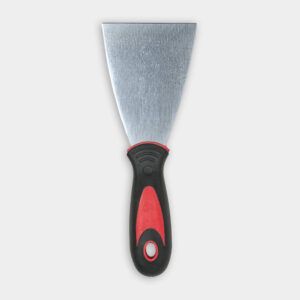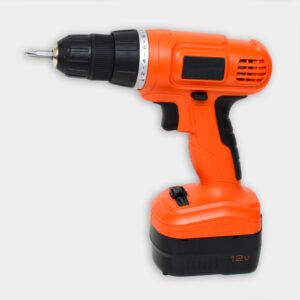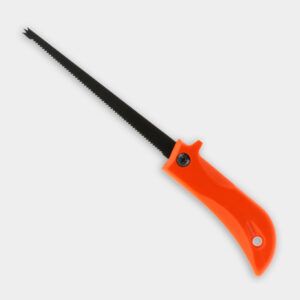We may be compensated if you purchase through links on our website. Our team is committed to delivering honest, objective, and independent reviews on home products and services.
Whether they’re caused by picture hooks, doorknobs, or accidental mishaps, drywall holes are a common type of household damage. Small holes are easy to fix with the right techniques and materials. This Old House general contractor Tom Silva demonstrates several effective methods for patching holes of various sizes, from tiny nail holes to larger drywall damage.
Understanding Different Wall Types
Understanding your wall construction type is helpful before any wall repair. Silva explains the two main types found in a home.
Plaster and Lath
This older system consists of wooden strips (lath) nailed horizontally across wall studs and covered with multiple plaster layers. The plaster is forced between the lath strips to create “keys” that lock it in place. A smooth finish coat, called a skim coat, is applied on top. Plaster and lath are often found in homes built before the mid-20th century.
Drywall
More common in modern construction, drywall consists of gypsum panels fastened directly to wall studs. Joints between panels are taped and covered with joint compound, then sanded smooth before painting. Drywall is easier to work with and repair than plaster and lath.
While the patching techniques are similar for both types, understanding your wall’s construction can help you choose the most appropriate repair method for longer-lasting and more seamless results.
Tools and Materials Needed to Repair Holes in Your Wall
To patch small holes in walls, you’ll need the following materials:
- Drill/driver
- Drywall tape
- Jab saw
- Joint compound
- Paint and primer
- Patching spackle
- Putty knife
- Sandpaper
- Scrap wood (for backing larger repairs)
- Small piece of drywall (for larger repairs)
Patching Tiny Holes in a Wall
For small holes, such as those left by picture hooks or small nails, Silva recommends using a simple patching spackle. This quick and easy method is perfect for minor wall damage and requires minimal tools and expertise. Here’s how to fill small holes easily:
- Apply a small amount of spackle to the hole using a putty knife.
- Press the spackle firmly into the hole, ensuring it’s completely filled.
- Smooth the surface with the edge of the putty knife.
- Allow the spackle to dry completely.
- Lightly sand the patched area if needed.
- Prime and paint to match the surrounding wall.
Repairing Medium-Sized Holes in a Wall
Silva demonstrates how to use an adhesive metal patch to repair holes larger than a nail hole but smaller than a fist. These patches are useful for repairing medium-sized holes because they offer additional support for the damaged area and help it maintain its strength. Follow these steps:
- Cut the metal patch to size, slightly larger than the hole.
- Peel off the backing and stick the patch over the hole.
- Use a putty knife to apply a thin layer of joint compound over the patch.
- Feather the edges of the compound to blend with the surrounding wall.
- Allow the compound to dry completely.
- Apply additional thin layers as needed, allowing each to dry between coats.
- Sand the repaired area smooth once fully dry.
- Prime and paint to match the wall.
Silva emphasizes the importance of applying multiple thin layers rather than one thick layer, which can lead to cracking and a more noticeable repair. The gradual layering will give you a smoother finish and a sturdier patch.
Fixing Large Holes in Drywall
This method is ideal for holes that are too big for a simple spackle or metal patch. Securing a piece of wood behind the patch ensures that the repair is solid and less likely to crack over time.
- Cut a square of drywall slightly larger than the damaged area.
- Hold the drywall piece over the hole and trace its outline on the wall.
- Use a jab saw to cut out the traced area, creating a clean opening.
- Insert a piece of scrap wood into the hole and secure it with drywall screws.
- Fit the drywall patch into the hole and screw it to the wood backing.
- Apply drywall tape around the edges of the patch.
- Cover the tape and screws with joint compound, feathering the edges.
- Allow to dry, then apply additional thin coats as needed.
- Sand smooth, prime, and paint to match the wall.
Patching Plaster Walls
Patching holes in plaster walls can be more challenging than repairing drywall. However, with some patience and precision, you can get the same seamless results:
- Clean the hole, removing any loose plaster and debris.
- If the hole is small, use patching spackle as you would for drywall.
- For larger holes, insert a mesh patch or use a piece of plasterboard as a backing.
- Apply a base coat of plaster, pushing it into the lath strips or mesh to create a good bond.
- Once the base coat is dry, apply a finish coat of plaster, smoothing it out to match the surrounding wall.
- Allow the plaster to dry completely, then sand if necessary.
- Prime and paint the repaired area to match the rest of the wall.
Tips for a Professional-Looking Finish for Your Walls
To achieve the best results when patching walls, follow these tips:
- Always clean the area around the hole before beginning repairs.
- Use a level when cutting larger patches to ensure straight edges.
- Apply joint compound in thin layers, building up gradually for a smoother finish.
- Sand between coats for a smoother finish.
- Use a wide putty knife for the final coat to create a seamless blend.
- Prime the entire patched area before painting to ensure color consistency.
Common Wall Patching Mistakes To Avoid
When patching walls, be careful to avoid these common errors:
- Applying too much spackle or joint compound at once. This can lead to cracking and a more noticeable repair.
- Failing to properly secure backing for larger patches. Backing ensures the patch’s stability.
- Neglecting to sand between coats of joint compound. Sanding ensures a smooth and even finish.
- Skipping the priming step before painting. Priming helps achieve color consistency with the rest of the wall.
- Rushing the drying process. Allow ample drying time between coats to prevent future issues.
Finishing Touches and Wall Maintenance
After you’ve successfully patched the holes, consider giving your walls a fresh coat of paint. This step isn’t always necessary, but it can improve your space’s appearance.
To keep your walls looking good for longer, clean them regularly to prevent dirt and grime buildup. Use wall protectors where doorknobs and furniture may cause dents or holes. Regularly inspect your walls for any signs of damage and address them promptly.



